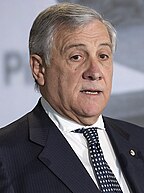
The politics of Italy are conducted through a parliamentary republic with a multi-party system. Italy has been a democratic republic since 2 June 1946, when the monarchy was abolished by popular referendum and a constituent assembly was elected to draft a constitution, which was promulgated on 1 January 1948.

The prime minister of Italy, officially the president of the Council of Ministers, is the head of government of the Italian Republic. The office of president of the Council of Ministers is established by articles 92–96 of the Constitution of Italy; the president of the Council of Ministers is appointed by the president of the Republic and must have the confidence of the Parliament to stay in office.
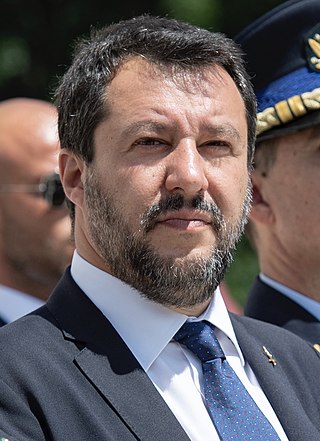
Matteo Salvini is an Italian politician who has served as Deputy Prime Minister of Italy and Minister of Infrastructure and Transport since 2022. He has been Federal Secretary of Italy's Lega Nord party since December 2013 and an Italian senator since March 2018. Salvini represented Northwestern Italy in the European Parliament from 2004 to 2018.
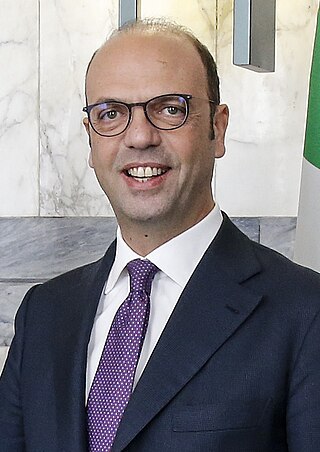
Angelino Alfano is an Italian former politician who served as Minister of Foreign Affairs from 12 December 2016 to 1 June 2018.

Paolo Gentiloni Silveri is an Italian politician who has served as European Commissioner for Economy in the von der Leyen Commission since 1 December 2019. He previously served as prime minister of Italy from December 2016 to June 2018.

The People of Freedom was a centre-right political party in Italy. The PdL launched by Silvio Berlusconi as an electoral list, including Forza Italia and National Alliance, on 27 February for the 2008 Italian general election. The list was later transformed into a party during a party congress on 27–29 March 2009. The party's leading members included Angelino Alfano, Renato Schifani, Renato Brunetta, Roberto Formigoni, Maurizio Sacconi, Maurizio Gasparri, Mariastella Gelmini, Antonio Martino, Giancarlo Galan, Maurizio Lupi, Gaetano Quagliariello, Daniela Santanchè, Sandro Bondi, and Raffaele Fitto.

The political career of Silvio Berlusconi (1994–2011) began in 1994, when Berlusconi entered politics for the first time serving intermittent terms as Prime Minister of Italy from 1994 to 1995, 2001 to 2006 and 2008 to 2011, his career was racked with controversies and trials; amongst these was his failure to honour his promise to sell his personal assets in Mediaset, the largest television broadcaster network in Italy, in order to dispel any perceived conflicts of interest.

The 2018 Italian general election was held on 4 March 2018 after the Italian Parliament was dissolved by President Sergio Mattarella on 28 December 2017. Voters were electing the 630 members of the Chamber of Deputies and the 315 elective members of the Senate of the Republic for the 18th legislature of the Italian Republic since 1948. The election took place concurrently with the Lombard and Lazio regional elections. No party or coalition gained an absolute majority in the parliament, even though the centre-right coalition won a plurality of seats as a coalition, and the Five Star Movement (M5S) won a plurality of seats as an individual party.
The centre-right coalition is a political alliance of political parties in Italy active under several forms and names since 1994, when Silvio Berlusconi entered politics and formed the Forza Italia party. It has mostly competed with the centre-left coalition. It is composed of right-leaning parties in the Italian political arena, which generally advocate tax reduction and oppose immigration, and in some cases are eurosceptic.

The Letta government was the 62nd government of the Italian Republic. In office from 28 April 2013 to 22 January 2014, it comprised ministers of the Democratic Party (PD), The People of Freedom (PdL), Civic Choice (SC), the Union of the Centre (UdC), one of the Italian Radicals (RI) and three non-party independents.

Forza Italia is a centre-right political party in Italy, whose ideology includes elements of liberal conservatism, Christian democracy, liberalism and populism. FI is a member of the European People's Party. Silvio Berlusconi was the party's leader and president until his death in 2023. The party has since been led by Antonio Tajani, who had been vice president and coordinatior and now functions as secretary. Other leading members include Elisabetta Casellati.

Luigi Di Maio is an Italian politician who has been serving as EU Special Representative for the Gulf region since 1 June 2023. Di Maio also served as Minister of Foreign Affairs from 2019 to 2022, as Deputy Prime Minister of Italy and Minister of Economic Development, Labour and Social Policies from 2018 to 2019, and as Vice President of the Chamber of Deputies in the 17th Italian legislature.
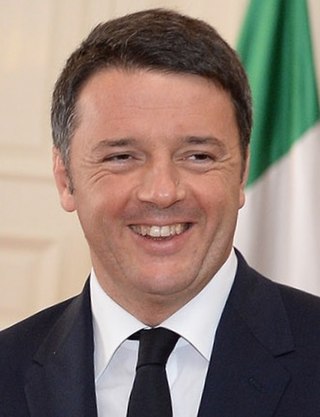
The Renzi government was the 63rd government of the Italian Republic, in office from February 2014 to December 2016. It was led by Matteo Renzi, secretary and leader of the centre-left Democratic Party (PD).

Maurizio Martina is an Italian politician and former member of the Chamber of Deputies, who served as secretary of the Democratic Party (PD) from March to November 2018, being appointed after the 2018 Italian general election. He served as Minister of Agricultural, Food and Forestry Policies from 22 February 2014 to 13 March 2018, in the governments of Matteo Renzi and Paolo Gentiloni. On 7 May 2017, he was elected Deputy Secretary of the Democratic Party. Martina resigned as Agriculture Minister and took over as acting secretary of the PD after Matteo Renzi resigned following a poor election showing in 2018.

The secretary of the Council of Ministers is a senior member of the Italian Cabinet. The secretary is one of the undersecretaries of state to the Presidency of the Council of Ministers but, unlike them, he sits in the Cabinet and helps the prime minister in coordinating the government and its meetings. Thus, the secretary is usually a person very close to the prime minister. The secretary of the Council of Ministers, which may not be confused with the largely ceremonial office of Deputy Prime Minister, resembles that of the White House chief of staff.
Popular Alternative is a Christian-democratic political party in Italy that was founded on 18 March 2017 after the dissolution of New Centre-Right (NCD), one of the two parties that emerged at the break-up of The People of Freedom. "Popular" is a reference to popolarismo, the Italian variety of Christian democracy. The party has been a member of the European People's Party (EPP) since its foundation, having inherited the membership of the NCD.

In the 2018 Italian general election, no political group or party won an outright majority, resulting in a hung parliament. On 4 March, the centre-right coalition, in which Matteo Salvini's League emerged as the main political force, won a plurality of seats in the Chamber of Deputies and in the Senate, while the anti-establishment Five Star Movement (M5S) led by Luigi Di Maio became the party with the largest number of votes. The centre-left coalition, led by Matteo Renzi and the then-governing Democratic Party (PD), came third. Protracted negotiations were required before a government formation could be ultimated.

The first Conte government was the 65th government of the Italian Republic. It was led by Giuseppe Conte, an independent, and it was in office from 1 June 2018 to 5 September 2019.
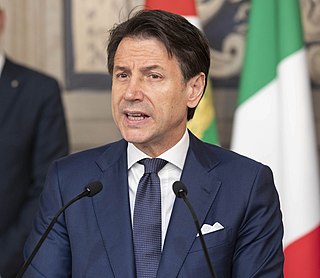
The 2019 Italian government crisis was a political event in Italy that occurred between August and September 2019. It includes the events that follow the announcement of the Minister of the Interior and leader of the League, Matteo Salvini, that he would revoke League's support of the cabinet and ask the President of the Republic to call a snap election. This provoked the resignation of Prime Minister Giuseppe Conte, and resulted in the formation of a new cabinet led by Conte himself.

